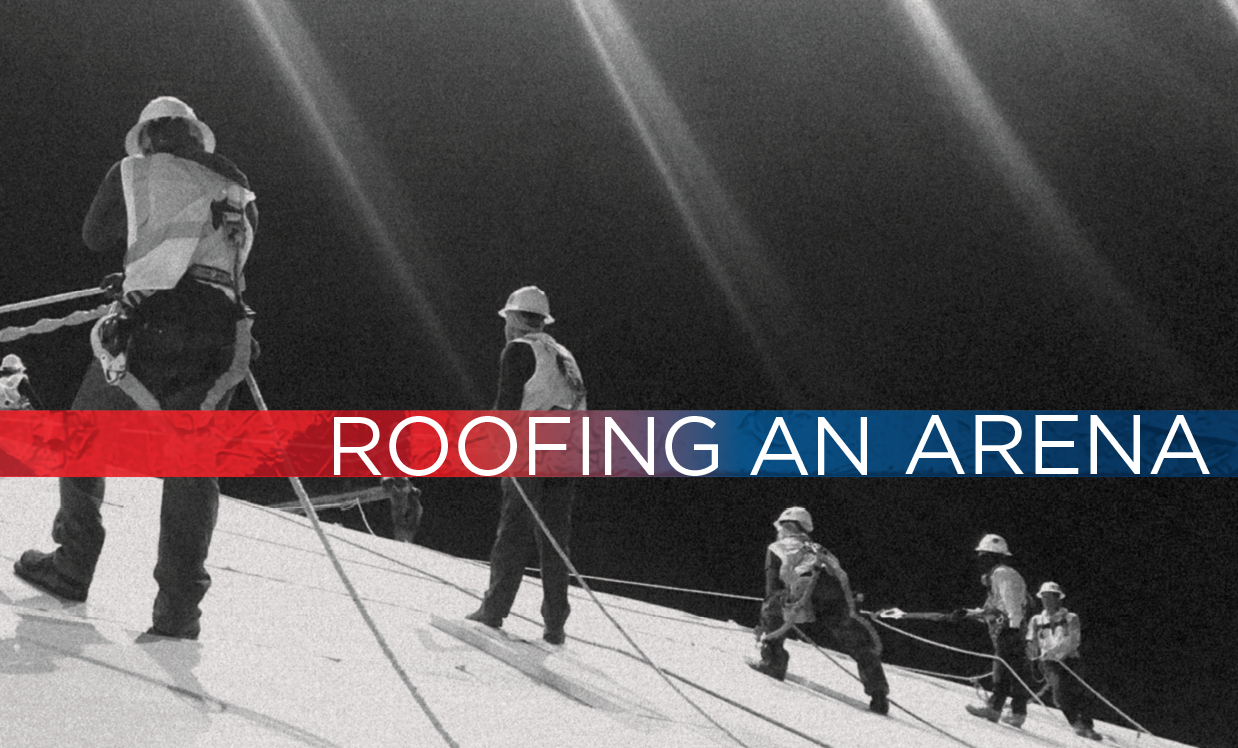As a building enclosure specialist with a background in roofing, I often am called to investigate persistent leak issues that end up having less to do with the roof than the rest of the building envelope.
Although roofing contractors usually are the first to be blamed for leaks, roofing contractors aren’t always able to properly diagnose certain chronic leak issues. Many clients throw away thousands of dollars on temporary solutions when they could have spent a fraction of that money on investigative services and correcting the problem on the first try. By following a set of key principles and a systematic approach to problem solving, you can determine a leak’s causes (that most likely are not the roof), keep your clients happy and ultimately save them money.
How it’s working now
With many areas of the U.S. experiencing more frequent heavy rainfalls, an increase in service requests for misdiagnosed roof leaks usually follows. Mechanical issues related to HVAC and commercial exhaust vents; exterior wall failures in veneers, doors and windows; drainage; and below-grade waterproofing issues end up falling under the purview of a roofing service technician to quickly and accurately identify and correct, usually with a predetermined contract price or an amount “not to exceed.”
What sometimes follows is a temporary repair attempt by a maintenance crew that is outside of its expertise. This pattern of crews responding to leak requests, performing temporary repairs and operating in good faith could continue indefinitely.
Occasionally, a mystery leak may be uncovered or exacerbated in this process by torrential rain events resulting in a hefty bill and an angry customer.
In Nashville, Tenn., where my company is based, the average commercial roofing service repair can be relatively expensive.
Combined with material and labor shortages with markup, the cost of repairs can be in the thousands. Including travel time, access/setup, repair time and cleanup, the average work order time runs anywhere from two to four hours if it’s within the normal service area radius of about 10-20 miles from the main office. That means, on average, customers can expect to spend a large amount per service repair call, making the efficiency of these repair calls increasingly more important.
Persistent leak calls will result in multiple visits from the same contractor and, in rare cases, multiple visits by multiple contractors. Before long, tricky leaks can result in thousands of dollars in damages and repair costs without ever reaching a clear solution for permanent repair. This scenario also doesn’t account for the hours lost in paperwork, scheduling and granting site access for multiple contractors as well as the loss of revenue because of endless distractions.
How it should work
However, with a carefully applied process of elimination, deductive reasoning and documentation, you can avoid these headaches simply by using a system of investigation that combines theory and practicality.
There are standard testing methods for water leakage, and ASTM E2128, “Standard Guide for Evaluating Water Leakage of Building Walls,” as well as ASTM D7053, “Standard Guide for Determining and Evaluating Causes of Water Leakage of Low-Sloped Roofs,” are often used when investigating leaks. The standards outline the following identical processes:
- Review project documents: This means all documents available such as original contract documentation, material shipments and invoicing. This allows you to compare what was supposed to happen with what actually happened.
- Evaluate design concepts: This allows you to review the intended building use vs. current use and any deviations from the original design, such as a reroof that covered existing through-wall flashing with a termination bar.
- Determine building service history: Service records can be checked against weather events and can tell you whether previous efforts have been effective.
- Inspect: Perform an initial site visit to familiarize yourself with the building before deciding how and where to test. Just like a doctor before surgery, you need to know what will happen, where and how.
- Perform investigative testing: At this stage, you must act on what has been uncovered thus far, ideally with immediate results.
- Analyze findings: Collect all case information to date and thoroughly consider all known possibilities before making a final determination.
- Report findings: As a matter of permanent record, compile your findings and deliver actionable information that will lead to results and demonstrate the value of investigative services.
This process serves as an excellent guide for fundamental testing approach and procedure. It establishes qualitative standards by which information can be collected and shared among building professionals no matter the trade or education.
However, the nuance is the lens through which the case is viewed and how the information is delivered to the client. In some cases, the information you collect may end up in the hands of a lawyer or judge. The report submitted may have far-reaching effects that exceed the current situation’s scope. Reports always should be written as objectively as possible, communicating only the information collected and observed.
Therefore, it’s imperative the information you deliver is clear and accurate in a form that can be easily and quickly digested. There is no need for flowery language or hard-to-decipher data. Basic storytelling with the best obtainable version of the truth is preferred. To do this, you can use what can be categorized as two types of testing: destructive and nondestructive. There are several tools to apply, and the sequence in which to use them can make or break a case. Those tools and form of application can be categorized as follows:
- Using your eyes for visual inspection is always the first step to determine signs of distress or failure so you will know how and where to apply the tools that follow.
- Rilem tube testing measures the rate of masonry absorption by simulating wind-driven rain over an extended period of time. This test can be interpreted in a couple ways depending on whether you follow the Rilem method of interval measurements or manufacturer’s warranty measurements. In a nutshell, placing a Rilem tube against the masonry surface of suspect areas with significant absorption during 20 to 30 minutes can be considered a red flag. You should follow the Rilem test method that comes with each kit and report results per those standards.
- Controlled water testing uses a pressure-regulated water spray rig apparatus while isolating building materials.
- Infrared imaging measures the temperature variation between ambient air and building materials to isolate the existence or potential for moisture intrusion and/or condensation.
- Moisture readings use a probe or contact moisture meter to register the existence of acceptable and unacceptable levels of moisture within building materials. You can interpret this distinction by taking baseline readings of areas known to be dry in a given material vs. readings known to be visibly saturated or wet, excluding direct contact with liquid and maintaining proper equipment calibration throughout testing. An example would be if you measured baseline dry readings of 17% in drywall during testing and found yourself registering 30% or more in suspect areas, you should note the anomaly and seek to find the source.
- When all else fails, take things apart and read the clues you find. In a building envelope, this usually translates to test cuts, core cuts of a roof system, veneer removal in exterior walls, etc.
Your job is to find the leak and propose a solution in the most efficient way possible with precision and accuracy. The most difficult part of this process is knowing how to manage the information you collect.
For example, absorptive veneer is less of a concern if proper moisture control has been incorporated into the design with a moisture retarder and through-wall flashing. You need to identify thermal variation in infrared imaging as either air stratification or moisture intrusion with visual confirmation and/or moisture readings. Moisture readings may indicate minimal condensation in metal framing studs but may not be the source of the leak. Water testing and destructive or disruptive removal generally are fail-safe ways of finding out what you are dealing with but may not always be the best choice for customers under certain circumstances such as packaging and food processing facilities where quality control is paramount.
My personal experience brings a few case studies to mind. In one instance, our team was called to solve a leak issue on an inverted roof membrane assembly system with concrete pavers and pedestals. The leak had persisted for more than five years and cost the customer more than $20,000 in service calls and repairs. After two site visits and roughly $3,000 in investigative services, we isolated the leak to a punctured membrane that would cost less than $500 to repair.
In another case, a commercial property manager had not paid a series of service invoices because the roof was under warranty and he believed the roof system was to blame for a persistent leak. A water test proved the source of entry was a deficient goose neck vent more than 30 feet away that would pond inside a right angle of the fabricated metal, overflow onto a metal truss and travel through three fire walls via a V-shaped channel at the top of the truss, drip onto metal stud framing and overflow onto the floor during sustained rain.
These examples show where the realms of theoretical knowledge and practical experience collide, sometimes with devastating effects. Meaning, in theory, if water is coming in from above it must be the roof, right? But practically speaking, the enclosure system must work together as a whole to function properly and often it is the transition points that fail.
I’ve had customers tell me: “There’s no way it’s my chimney leaking; it must be the roof because the stains are on my ceiling.” In theory, this statement makes sense. But practically speaking, if your chimney has voids in the mortar joints and no through-wall flashing, it’s typically the chimney to blame more than the roof but you still must address both. Testing can help demonstrate this to customers.
Communicating these concepts is painstaking work. Unfortunately, it’s the customer who tends to suffer the most. This is why some companies opt for due diligence investigations on existing buildings before beginning successive phases of construction. That way, in measured steps, skilled inspectors can visually assess the situation, recommend testing and then make the best recommendations for repairs or replacement to follow.
For example, a thorough investigative infrared contract in the tens of thousands of dollars makes far more sense than errant claims regarding preexisting moisture intrusion. These debates sometimes happen in reroofing projects. An owner might claim the contractor installed wet polyisocyanurate when the base layers were wet all along. This kind of argument could halt production and cost hundreds of thousands if not millions of dollars in lost revenue and investigative and legal fees. If considered upfront, it could be investigated and verified for a fraction of the overall roofing budget.
Communication is key
Moisture intrusion investigation information must be presented using qualitative and quantitative analysis so all parties involved can act on that information quickly and decisively. But it primarily is the marriage of theory and practicality, combining the carefully considered technical requirements set forth by a designer to be executed using the invaluable experience of a skilled installer. Bridging this gap may be a challenge, but it is necessary industry professionals learn from frequent, repetitive mistakes using investigative processes and reporting.
We should be humbled by the challenges we face in solving difficult problems in our industry while sharing what we learn along the way. Ernest Hemingway wrote: “There are some things which cannot be learned quickly, and time, which is all we have, must be paid heavily for their acquiring. They are the very simplest things and because it takes a man’s life to know them the little new that each man gets from life is very costly and the only heritage he has to leave.”
Nick Warndorf, RRO, is a building envelope consultant with Smith Seckman Reid, Nashville, Tenn.



